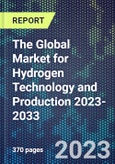Hydrogen technology and production is a key part of decarbonization strategies and a means to achieve direct electrification. The three main types of hydrogen are grey hydrogen, blue hydrogen and green hydrogen.
The Global Market for Hydrogen Technology and Production 2023-2033 covers all elements of this fast-growing market. Future market development and low-carbon innovation is driven by green hydrogen (electrolyzers) and blue hydrogen technologies.
Other important elements include:
- storing and transporting hydrogen.
- hydrogen fuel cells.
- hydrogen vehicles including taxis, planes and cars.
Report contents include:
- Analysis of current hydrogen production (grey, brown etc.) and demand forecasts to 2033.
- Market value chain and industry map.
- Market drivers, trends and challenges.
- Hydrogen production processes and costs.
- Recent industry developments and investments and start-up funding.
- Market analysis of hydrogen technology and production including blue hydrogen (from decarbonised natural gas), green hydrogen (from renewable power and electrolysis), carbon capture, hydrogen storage & transport, hydrogen fuel cells and hydrogen vehicles.
- Profiles of 175 companies including multi-nationals, large corporations and start-ups. Companies profiled include Advanced Ionics, Electric Hydrogen, Enapter, FuelCell Energy, Heliogen, HiiROC, Ionomr Innovations, Monolith Materials, Ohmium, PowerCell Sweden, Thiozen and Verdagy.
This product will be delivered within 1-3 business days.
Table of Contents
1 RESEARCH METHODOLOGY
2 INTRODUCTION
3 MARKET ANALYSIS
List of Tables
List of Figures
Companies Mentioned (Partial List)
A selection of companies mentioned in this report includes, but is not limited to:
- Advanced Ionics
- Advent Technologies
- AFC Energy
- Agfa-Gevaert
- Air Liquide
- Air Products
- Alchemr
- AlGalCo
- Altergy Systems
- Aepnus
- Atawey
- Aurora Hydrogen
- AquaHydrex
- Avium, LLC
- Ballard Power Systems
- BASF
- BayoTech
- Bloom Energy
- BP
- Bramble Energy
- CAPTICO2
- Cavendish Renewable Technology
- Celcibus
- Ceres Power
- Cgon
- Chiyoda Corporation
- CO2 Capsol
- Convion
- Cummins
- Cutting-Edge Nanomaterials UG
- C-Zero
- DENS
- Dioxide Materials
- Ecolectro
- EH Group
- Enocell
- Erredue
- 8Rivers
- Ekona Power
- Elcogen
- Electriq Global
- Electric Hydrogen
- Elogen
- Elcogen
- Enapter
- Eni
- Epro Advance Technology Limited
- Ergosup
- EvolOH
- Evolve Hydrogen
- FirstElement Fuel
- FuelCell Energy
- FuMA-Tech
- Fusion Fuel
- Genomines
- Graforce
- GeoPura
- Green Hydrogen Systems
- GRZ Technologies
- Hazer Group
- Heliogen
- Hexagon Purus
- HiiROC
- H2B2
- H2Electro
- H2Greem
- H2-Industries
- H2Pro
- H2U Technologies
- Honeywell UOP
- Horisont Energi
- Horizon Fuel Cell Technologies
- H Quest Vanguard
- H-Tec Systems
- Hymeth
- Hynamics
- Hycamite
- Hydra Energy
- Hydrogen in Motion
- Hydrogenious Technologies
- Hydrogenera
- Hydro X
- Hynertech
- Hyundai
- HySiLabs
- Hysata
- Hystar
- Hyzon Motors
- Immaterial
- Inergio
- Inpex
- Innova Hydrogen
- Ionomr Innovations
- ITM Power
- John Cockerill
- Johnson Matthey
- Keyou
- Levidian
- Linde
- Loop Energy
- Lhyfe
- McPhy
- Mebius
- Modern Electron
- Mote
- Monolith Materials
- NEL Hydrogen
- NEOM Green Hydrogen Project
- Next Hydrogen Solutions
- Nikola Motor Company
- Norled
- NPROXX
- Nuberg PERIC
- Nu:iconic
- NuMat Technologies
- Ohmium
- 1s1 Energy
- OneAtom 12
- Orion Polymer
- OxEon Energy
- Pani Clean Inc
- Pajarito Powder
- Permascand AB
- pH Matter
- Plantery Technologies
- Plasma Kinetics
- Plenesys
- Plug Power
- PowerUP Energy Technologies
- Proton Technologies
- Power to Hydrogen
- PowerCell Sweden
- Proton onsite
- P2X Solutions
- Quantron
- Raven SR
- ReCarbon
- Riversimple
- Rouge H2
- Ryze Hydrogen
- SeeO2 Energy
- SEID AS
- Shell
- sHYp
- Siemens
- Solenco Powerbox NV
- Sparc Technologies
- Standing Wave Reformers
- StoreH
- SungreenH2
- SunHydrogen
- Supercritical Solutions
- Svante
- Sylfen
- Sypox
- Syzygy Plasmonics
- TECO 2030
- Tevva
- Thiozen
- Thor Hydrogen
- TIANJIN Mainland
- TFP Hydrogen
- Topsoe
- Total Energies
- Toyota
- Transform Materials
- Universal Hydrogen
- Verdagy
- Versogen
- Xcel
- Xebec
- ZEG Power
- ZeroAvia
- Zhero
- ZoneFlow Reactor Technologies
Methodology

LOADING...








